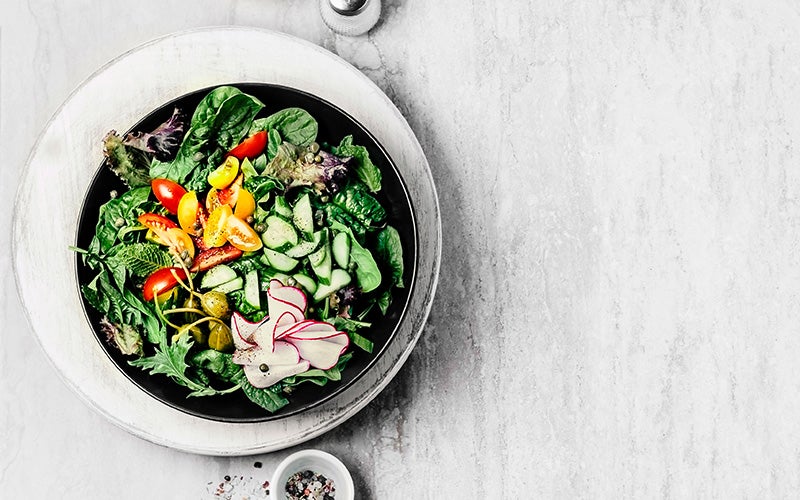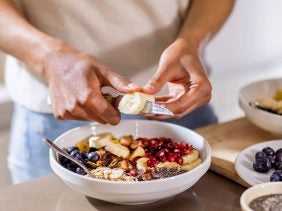Hydrating Foods for Hot Summer Days
 ©Claudia Totir
©Claudia Totir
Hydrating foods are the perfect summer food for any and all athletes. But why are they so healthy and which foods contain the most water?
What Are Hydrating Foods?
According to common definitions used in nutrition science, hydrating foods are foods that naturally contain more than 50 percent water.
At the top of the list of foods with high water content are fruits and vegetables, but beef and some cheeses also make this list, depending on how they’re processed. Nuts, seeds, and similar foods have the lowest water content.
Did you know: Officially, water also falls into the category of food. It’s essential for staying alive, plays a fundamental role in your metabolism, and often contains many important minerals. From a nutrition point of view, it differs from other foods in that it has no calories. But that does mean that the most hydrating food, with a water content of 100 percent, is water itself.
How Much Water Do I Need?
Quite a bit. Adult humans are made up of 55 – 60% water. For a person weighing 70 kilograms, that equates to about 40 liters. When temperatures are normal, you should consume approx. 35-40 ml of water per kilo of body weight per day – that’s usually 2-3 liters a day – to maintain hydration.
The NHS recommends a daily water intake of 6-8 glasses (or other fluids) to meet your body’s needs. Since fruit and veggies are the majority of your diet in the Eatwell guide, this recommendation also takes into account fluid intake from foods with a high water content.
By the way, dehydration already has noticeable effects when you lose 2 percent of your body’s water content, so between 600 and 900 ml. From that point on, your performance drops significantly. That’s why athletes should make sure they’re staying hydrated, especially during workouts.
In hot temperatures or when you’re exercising, you’ll lose more fluids than usual. Consume 1-2 additional liters of fluid per hour of exercise to stay on the safe side. Since you also lose minerals when you sweat, drinking water is not always enough to stay hydrated. Isotonic drinks or hydrating foods are a better choice for keeping your body in balance.
This is especially true for endurance athletes whose daily lives often involve lots of exercise in extreme temperatures. That’s why we developed our Endurance Drink; its perfect mix of minerals and carbs keeps you on track. Even when the heat is on.
Three Reasons to Eat Hydrating Food
#1 Water-rich foods hydrate!
Foods with a high water content make an important contribution to your body’s water needs. In an average balanced diet, about 25-30 percent of your water intake comes from foods each day. Of course, that means you still need to drink enough fluids – preferably lots of water and unsweetened teas.
#2 They have tons of nutrients
Fruits and veggies are full of important nutrients, such as vitamins A and C, minerals, and fiber. Make sure to eat foods with a high-water content, and you’ll automatically reap the other health benefits.
#3 They can help you lose weight
Foods with a high-water content usually have few calories per cup but a lot of volume. Vegetables, in particular, are also high in fiber, which fills up space in your stomach and helps you maintain your calorie deficit – the fundamental requirement for weight loss.
By the way, just drinking water doesn’t have the same effect: foods with lots of water by weight have to be digested by the stomach and their nutrients processed accordingly. That’s why they remain longer in your stomach.
Water has a different effect: Since your body can only absorb a certain amount of pure water per hour, the rest just passes through your system. So instead of staying full, you just have to pee more.
Our calorie chart gives you an overview of the calorie content of fruits, vegetables, and other foods.
Our Top 20 Foods with a High Water Content
Our list of favorites includes fruits and veggies (plus whey!) that have a water content of 90 percent or more. Of course, there’s more than we can list here, so search around until you find your own favorite hydrating food.
Our 20 hydrating food favorites:
- cucumber 97%
- watermelon 96%
- iceberg lettuce 96%
- butterhead lettuce 95%
- tomatoes 95%
- whey 94 %
- napa cabbage 94
- radish 94 %
- zucchini 94 %
- green asparagus 94 %
- lamb’s lettuce 93 %
- mushrooms 93 %
- white asparagus 93 %
- celery 92 %
- eggplant 92 %
- swiss chard 92 %
- raw spinach 92 %
- strawberries 91 %
- arugula 91 %
- papaya 90 %
By the way, it’s easy to underestimate the water content of most foods. Fresh fruits and vegetables contain more than 50 percent water so, with a balanced diet that includes lots of veggies, you’re always on the right track.
How to Integrate Water Rich Foods Into Your Routine
#1 Eat your greens
It really is that simple: fruits and veggies have the highest percentages of water. Eat your three servings of vegetables and two servings of fruit every day and you’ll get a healthy dose of water alongside your beta carotene, vitamin K, and B vitamins! Having a hard time doing that? Then try our 7-Day Vegan Challenge and we’ll have you eating enough veggies in no time at all!
#2 Cook at home
How much water your food actually contains in the end mostly depends on the way it’s prepared. Up your hydration by cooking for yourself as often as possible and treating yourself regularly to a salad with tomatoes, cucumber, and your favorite vegetables.
Find some inspiration for healthy dishes that are high in water in our free recipe database.
#3 Get creative
Vegetables are incredibly versatile. Sure, when you grill fruits and veggies, like bell peppers and tomatoes, you lose a few percent of their water. Still, pineapple from the barbecue tastes fantastic. For a cool boost of vitamin C, turn watermelon into the perfect ice pop, so you won’t lose your appetite, even in the heat!
Don’t forget to drink!
No matter how much watermelon and other juicy raw fruits you eat: Don’t forget your fluids! Bored with plain ol’ H2O? Make your water tastier by infusing it! Infused water with herbs and cucumber, or apple cider vinegar, lemon, and chia seeds is the perfect low-calorie refreshment for every day.
Infusing isn’t enough for you in the long run? Then we have some solutions for you! Our CocoWhey and Sparkling Aminos, provide you with the fluids you need, plus even more goodies. Each set of nutrients is perfectly tailored to your fitness goals.
While we’re on the subject: More tips to drink more water every day.
Can you drink too much water?
Yes, but you’ll have to work at it. An adult human can drink about 8-10 liters of water a day. Drink more than that and you’re at risk of water intoxication: Since water acts as a transport medium for electrolytes, drinking too much water flushes important minerals out of your system, especially salt. This kind of nutrient imbalance can happen more easily to endurance athletes, which is why isotonic drinks are especially useful for them.
If you run long distances and sweat a lot in hot weather, you should always bring isotonic drinks like our CocoWhey with you when you run for an hour or more.
Conclusion
- Hydrating food can help you prevent dehydration.
- Fruits and vegetables have the highest water content.
- The majority of foods with a high-water content also have other heath benefits: they contain many micronutrients and often vitamin C.
- Watermelon, strawberries, radishes, tomatoes, asparagus, cucumber, iceberg lettuce, celery, and similar fruits and veggies can help you lose weight because they’re low in calories and high in volume.
- No matter what you eat, always drink at least 1.5 liters of water daily. Unsweetened liquids such as tea or juice spritzers in a 3:1 ratio are also a good idea.
Sources for this article
We at foodspring use only high-quality sources, including peer-reviewed studies, to support the facts within our articles. Read our editorial policy to learn more about how we fact-check and keep our content accurate, reliable, and trustworthy.





























